Musical Instrument: Organ
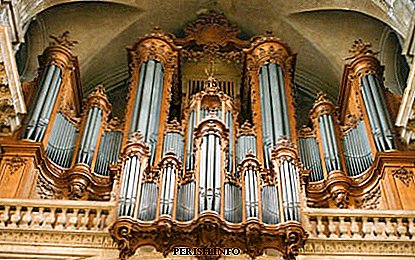
The world of musical instruments is rich and diverse, so traveling through it is very informative and at the same time fascinating activity. The instruments differ from each other in form, size, device and method of sound extraction and, as a result, are divided into different families: strings, wind, percussion and keyboard. Each of these families, in turn, is divided into different types, for example, violin, cello and double bass, belong to the category of stringed stringed instruments, and guitar, mandolin and balalaika are stringed and plucked. French horn, trumpet and trombone are counted as brass instruments, while bassoon, clarinet and oboe are counted as woodwind instruments. Each musical instrument is unique and takes up a specific place in musical culture, for example, an organ is a symbol of beauty and mystery. It does not belong to the category of very popular instruments, since not everyone can even learn to play on it, even a professional musician, but deserves special attention. Anyone who ever hears the organ "live" in the concert hall will be impressed for life, its sound fascinates and leaves no one indifferent. It creates the feeling that the music is pouring from the sky and that this is the creation of someone above. Even the appearance of the instrument, which is unique, evokes a feeling of irrepressible delight, therefore, the organ is called the "king of musical instruments" for a reason.
Sound
The sound of an organ is a powerful emotionally influencing multi-voiced texture that causes delight and inspiration. It is amazing, subdues the imagination and is able to bring to ecstasy. The sound capabilities of the instrument are very large, in the vocal palette of the organ you can find very different colors, because the organ is able to imitate not only the sounds of many musical instruments, but also birds singing, the noise of trees, the roar of rockfalls, even the sound of Christmas bells.
The organ has extraordinary dynamic flexibility: it is possible to perform both the gentlest pianissimo and deafening fortissimo. In addition, the sound frequency range of the instrument is within the limits of the infra and ultrasound regions.
A photo:
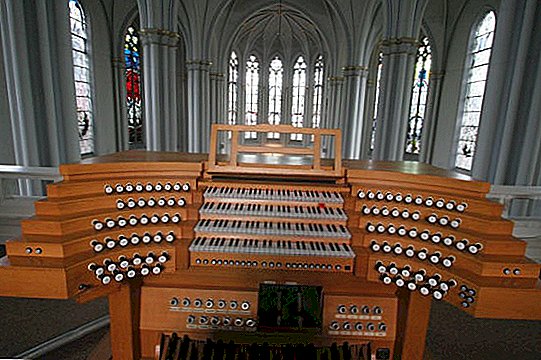
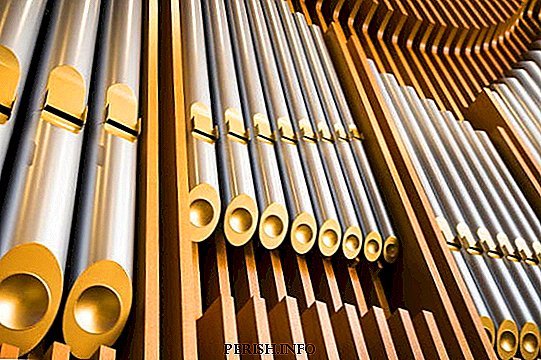

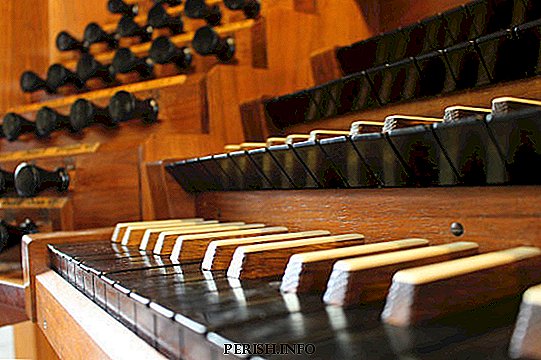
Interesting Facts
- The organ is the only musical instrument that has a permanent residence permit.
- The organist is the name of an organ musician.
- The concert hall in Atlantic City (USA) is famous for the fact that its main body is considered the largest in the world (455 registers, 7 manuals, 33112 pipes).
- The second place belongs to the body of Vanameuker (Philadelphia USA). It weighs about 300 tons, has 451 registers, 6 manuals and 30067 pipes.
- The next largest organ is the Cathedral of St. Stephen, which is located in the German city of Passau (229 registers, 5 manuals, 17774 pipes).
- The instrument, the forerunner of the modern organ, was already popular in the first century of our era, during the reign of Emperor Nero. His image is found on the coins of that time.
- During World War II, the German soldiers, the Soviet BM-13 multiple launch rocket systems, popularly known as Katyusha, were called “Stalin’s organ” because of the frightening sound.
- One of the oldest partially preserved specimens is an organ, the production of which dates from the 14th century. The instrument is currently an exhibit at the Stockholm National Historical Museum (Sweden).
- In the 13th century, small organs with a positive name were actively used in field conditions. Outstanding director S. Eisenstein in his film "Alexander Nevsky" for a more real image of the enemy camp - the camp of the Livonian knights, used a similar tool in the scene while serving as a bishop of the mass.
- The one-of-a-kind organ in which pipes made of bamboo were used was established in 1822 in the Philippines, in the city of Las Piñas, in the Church of St. Joseph.
- The most prestigious international competitions of organists at the present time are: the competition named after M. Čiurlionis, (Vilnius, Lithuania); A.Gedike Competition (Moscow, Russia); name contest I.S. Baha (Leipzig, Germany); competition of performers in Geneva (Switzerland); Competition named after M. Tariverdiev (Kaliningrad, Russia).
- The largest organ of Russia is located in the Cathedral of Kaliningrad (90 registers, 4 manuals, 6.5 thousand pipes).
Design
The organ is a musical instrument that includes a huge amount of various details, therefore a detailed description of its construction is rather complicated. The body is always made individually, as it is necessarily determined by the size of the building in which it is installed. The height of the instrument can reach 15 meters, the width varies within 10 meters, the depth is about 4 meters. The weight of such a huge structure is measured in tons.
It has not only very large dimensions, but also a complex structure, including pipes, a machine, and a complex control system.

There are a lot of pipes in the organ - several thousand. The length of the largest pipe is more than 10 meters, the smallest is several centimeters. The diameter of large pipes is measured in decimeters, and small - in millimeters. For the manufacture of pipes using two materials - wood and metal (a complex alloy of lead, tin and other metals). The shapes of the pipes are very diverse - they are a cone, a cylinder, a double cone and others. The pipes are arranged in rows, not only vertically, but also horizontally. Each row has the voice of an instrument and is called a register. Registers in the body in the tens and hundreds.
The organ management system is a performing board, which is otherwise called an organ chair. Here are the manuals - manual keyboard, pedal - keyboard for the legs, as well as a large number of buttons, levers, as well as various control lights.
Levers located on the right and left, as well as above the keyboards, turn the instrument registers on and off. The number of levers corresponds to the number of instrument registers. A signaling indicator is set above each lever: it lights up if the register is on. The functions of some levers are duplicated by buttons located above the foot keyboard.
Also above the manual there are buttons that have a very important purpose - this is the memory of organ control. With her help, the organist before the performance can program the order of switching registers. When you press the buttons of the storage mechanism of the instrument registers are included in a certain order automatically.
The number of manual keyboards - manuals on the organ, varies from two to six, and they are located one above the other. The number of keys on each manual is 61, which corresponds to the range of five octaves. Each manual is associated with a specific group of pipes, and also has its own name: Hauptwerk. Oberwerk, Rückpositiv, Hinterwerk, Brustwerk, Solowerk, Choir.
The foot keyboard, which extracts very low sounds, has 32 widely spaced pedal keys.
A very important component of the instrument are furs, the air in which is injected with the help of powerful electric fans.
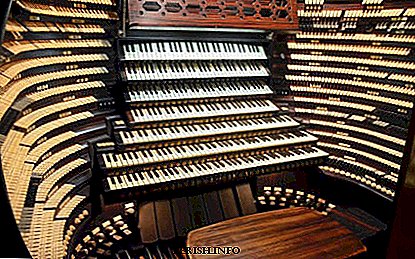
Application
The body today, as in former times, is used very actively. It is also used for accompaniment in Catholic and Protestant worship services. Quite often, churches with organs serve as a kind of "decorated" concert halls in which concerts are held not only for organ music, but also for chamber and symphonic music. In addition, at present, organs are installed in large concert halls, where they are used not only as solo, but also accompanying instruments. The organ sounds beautifully with chamber ensemble, vocalists, choir and symphony orchestra. For example, organ parts are included in scores of such wonderful works as The Poem of Ecstasy and Prometheus by A. Scriabin, symphony No. 3 by C. Saint-Saens. The organ also sounds in the program symphony "Manfred". P.I.Tchaikovsky. It is worth noting that although not often, the organ is used in opera performances such as Faust by S. Gounod, Sadko by N.A. Rimsky-Korsakov, Othello by D. Verdi, Orleansky Maiden by P.I. Tchaikovsky.
It is important to note that the music for the organ is the fruit of the works of very talented composers, among whom in the 16th century: A. Gabriely, A. Cabezon, M. Claudio; in the 17th century: JS Bach, N. Grigny, D. Buxtehude, I. Pachelbel, D. Frescobaldi, G. Purcell, I. Froberger, I. Reincken, M. Weckmann; in the 18th century V.A. Mozart, D. Zipoli, G.F. Handel, V.Lubeck, I. Krebs; in the 19th century M. Bossi, L. Boelman, A. Bruckner, A. Guilman, J. Lemmens, G. Merkel, F. Moretti, Z. Neuk, C. Saint-Sauns, G. Forêt, M. Churlenis. M. Reger, Z. Karg-Elert, S. Frank, F. List, R. Schumann, F. Mendelssohn, I. Brams, L. Vierne; in the 20th century P. Hindemith, O. Messiaen, B. Britten, A. Onegger, D. Shostakovich, B. Tishchenko, S. Slonimsky, R. Shchedrin, A. Goedicke, S. Widor, M. Dupre, F. Novoveisky , O. Yanchenko.
Famous Performers

From the very beginning of its appearance, the organ attracted much attention. Playing the music on the instrument was always not an easy task, and therefore only truly talented musicians could be real virtuosos, and besides, many of them composed music for the organ. Among the performers of the past, such famous musicians as A. Gabriely, A. Cabezon, M. Claudio, I. S. Bach, N. Grigni, D. Buxtehude, I. Pachelbel, D. Frescobaldi, I. Froberger, and Reincken, M. Weckmann, V. Lubeck, I. Krebs, M. Bossi, L. Boelman, Antoen Bruckner, L. Vierne, A. Gilman, J. Lemmens, G. Merkel, F. Moretti, Z. Nojk, K. Saint-Sanes, G. Foret M. Reger, Z. Karg-Elert, S. Frank, A. Goedicke, O. Yanchenko. There are a lot of talented organists at the present time, it’s impossible to list them all, but here are some of them: T. Trotter (Great Britain), G. Martin (Canada), H. Inoue (Japan), L. Rogg (Switzerland), F. Lefebvre , (France), A. Fiseysky (Russia), D. Briggs, (USA), U. Marshall, (United Kingdom), P. Planiavsky, (Austria), U. Benig, (Germany), D. Gettshe, (Vatican ), A. Uibo, (Estonia), G. Edenstam, (Sweden).
Organ history
The unique history of the body begins in very old times and has several millennia. Art historians assume that the ancestors of the organ are three ancient instruments. Initially, this is a Pan multi-flute consisting of several reed tubes of different lengths attached to each other, each of which makes only one sound. The second instrument was the Babylonian bagpipe, where a fur chamber was used to create sound. And the third progenitor of the organ is considered to be Chinese sheng - a wind instrument, with vibrating reeds inserted into bamboo tubes attached to the resonator body.
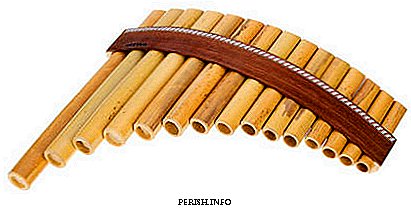
The musicians playing the flute of Pan dreamed that it would have a wider range, for which they added a number of sound tubes. The instrument was very large, and playing it was rather inconvenient. Once, the famous ancient Greek mechanic Kteziby, who lived in the second century BC, saw and regretted the unfortunate flutist, who had difficulty managing with a cumbersome instrument. The inventor figured out how to make it easier for the musician to perform the instrument and adapted it to the flute for air supply, first one piston pump, and then two. In the future, Ktesiby for an even supply of air flow and, consequently, a smoother sound science, improved his invention by attaching a reservoir to the structure, which was located in a large container with water. This hydraulic press facilitated the work of the musician, as he freed him from blowing air into the instrument, but required the presence of two more people who had to pump the pumps. And so that the air did not go to all the pipes, but to the one that was supposed to sound at the moment, the inventor adapted special valves to the pipes. The task of the musician was to open and close them at the right time and in a certain sequence. Ktezibiy called his invention hydravlos, that is, the "water flute", but the people began to call it simply "organ", which translated from Greek means "instrument". What the musician dreamed about was accomplished, the range of the hydraulic fluid has greatly expanded: a large number of pipes of different sizes were added to it. In addition, the organ acquired the function of polyphony, that is, it could, unlike its predecessor Flute Pan, simultaneously produce several sounds. The organ of that time had a sharp and loud sound, so it was effectively used in public shows: gladiator battles, chariot competitions and other similar performances.
Meanwhile, the musical masters continued to work on improving the instrument, which is becoming increasingly popular. In the days of early Christianity, the Ktezibiya hydraulic design was replaced with furs, and then with the whole system of furs, which significantly improved the sound quality of the instrument. The size and number of pipes increased significantly. In the 4th century AD, organs had already reached a large size. The countries in which they received the most intensive development were France, Italy, Germany and Spain. However, for example, in the 5th century, the tools installed in most Spanish temples were used only during major divine services. Changes occurred in the VI I century, namely in 666, when, by special order of the Pope Vitaly, the sound of the organs became an integral part of the Catholic Church worship. In addition, the tool was a mandatory attribute of various imperial ceremonies.
The improvement of the organ continued at all times. The size of the instrument and its acoustic capabilities grew very intensively. The number of pipes, which, for a variety of timbre colors, were made both metal and wooden, has reached several hundred. The bodies acquired enormous size and began to be built into the walls of the temples. The bodies made by masters from Byzantium were considered the best instruments of that time, in the 9th century the center of their production moved to Italy, and later the German masters mastered this complex art. XI century characterizes the next stage in the development of the tool. Organs were built, differing in shape and size - real works of art. Wizards continued to work on the modernization of the tool, for example, a special table was designed with keyboards, called manuals. However, execution on such an instrument was not an easy task. The keys were huge, their length could be up to 30 cm, and -10 cm wide. The musician did not touch the keyboard with his fingers, but with his fists or elbows.
XIII century - a new stage in the development of the tool. There were small portable organs, called portable and positive. They quickly gained popularity, as they were adapted for hiking conditions and were mandatory participants in military operations. These were compact tools with a small number of pipes, one row of keys and a fur chamber for blowing air.
In the XIV-XV centuries, the body becomes even more popular and, accordingly, is developing intensively. A keyboard for the legs and a large number of levers that switch voices and registers. The capacity of the organ increased: it could imitate the sound of various musical instruments and even the singing of birds. But most importantly, the key sizes were reduced, which led to the expansion of the organists' performing abilities.
In the XVI-XVII centuries, the body becomes an even more complex instrument. His keyboard on different instruments could vary from two to seven manuals, each of which contained a range of up to five octaves, and a special console was designed to control the music giant. At this time, such wonderful composers as D. Frescobaldi, J. Sweelink, D. Buxtehude, I. Pachelbel worked for the instrument.
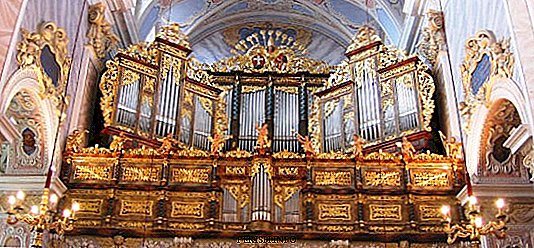
The 18th century is considered the “Golden Age of the Authority.” The construction and performance of the instrument reached unprecedented heyday. Organs built during this period had a wonderful sound and transparency of timbre. And the greatness of this instrument was perpetuated in the works of genius I.S. Baha.
The XIX century was also marked by innovative research in organ construction. The talented French master Aristide Kawaye-Kohl as a result of constructive improvements modeled the instrument, which was more powerful in sound and scale, and also had new timbres. Such organs later became known as symphonic.
At the end of the 19th and the beginning of the 20th century, the organs began to be supplied with various electrical and then electronic devices.
The organ is not accidentally called the "king of music", it has always been the most ambitious and mysterious musical instrument. His majestic sound, which possesses great persuasive power, leaves no one indifferent, and the emotional impact of this instrument on the listener is immeasurable, as music of a very wide range is subject to it: from cosmic reflections to subtle mental human experiences.

Leave Your Comment